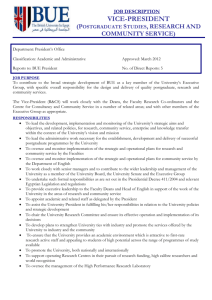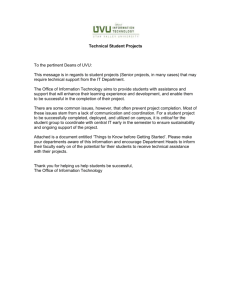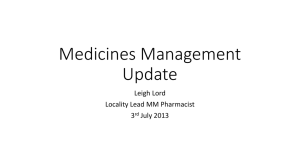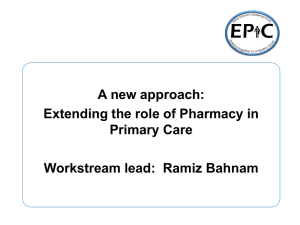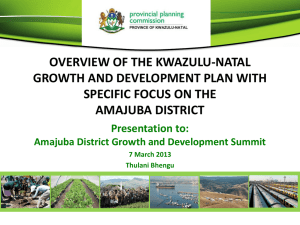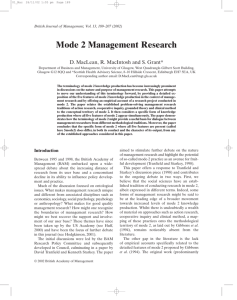Crump Report
advertisement
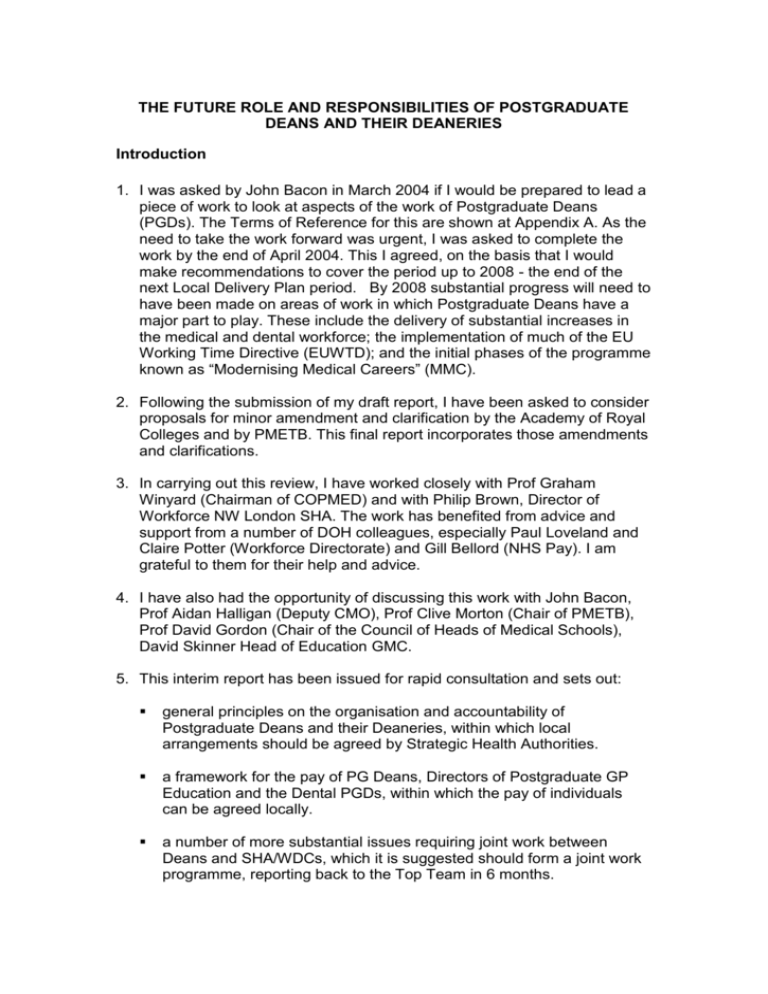
THE FUTURE ROLE AND RESPONSIBILITIES OF POSTGRADUATE DEANS AND THEIR DEANERIES Introduction 1. I was asked by John Bacon in March 2004 if I would be prepared to lead a piece of work to look at aspects of the work of Postgraduate Deans (PGDs). The Terms of Reference for this are shown at Appendix A. As the need to take the work forward was urgent, I was asked to complete the work by the end of April 2004. This I agreed, on the basis that I would make recommendations to cover the period up to 2008 - the end of the next Local Delivery Plan period. By 2008 substantial progress will need to have been made on areas of work in which Postgraduate Deans have a major part to play. These include the delivery of substantial increases in the medical and dental workforce; the implementation of much of the EU Working Time Directive (EUWTD); and the initial phases of the programme known as “Modernising Medical Careers” (MMC). 2. Following the submission of my draft report, I have been asked to consider proposals for minor amendment and clarification by the Academy of Royal Colleges and by PMETB. This final report incorporates those amendments and clarifications. 3. In carrying out this review, I have worked closely with Prof Graham Winyard (Chairman of COPMED) and with Philip Brown, Director of Workforce NW London SHA. The work has benefited from advice and support from a number of DOH colleagues, especially Paul Loveland and Claire Potter (Workforce Directorate) and Gill Bellord (NHS Pay). I am grateful to them for their help and advice. 4. I have also had the opportunity of discussing this work with John Bacon, Prof Aidan Halligan (Deputy CMO), Prof Clive Morton (Chair of PMETB), Prof David Gordon (Chair of the Council of Heads of Medical Schools), David Skinner Head of Education GMC. 5. This interim report has been issued for rapid consultation and sets out: general principles on the organisation and accountability of Postgraduate Deans and their Deaneries, within which local arrangements should be agreed by Strategic Health Authorities. a framework for the pay of PG Deans, Directors of Postgraduate GP Education and the Dental PGDs, within which the pay of individuals can be agreed locally. a number of more substantial issues requiring joint work between Deans and SHA/WDCs, which it is suggested should form a joint work programme, reporting back to the Top Team in 6 months. proposals for a joint secretariat function linked to the Office of the 28 SHAs, incorporating the current support arrangements for the WDC Standing Conference and for COPMeD, COGPeD and COPDenD. Main Roles and Responsibilities 6. The role and responsibilities of Postgraduate Deans and their Deaneries in England and the organisational context in which they work, has evolved considerably over the last few years. Most recently Shifting the Balance of Power (StBoP) and the associated changes in the Department of Health have altered lines of managerial and professional accountability, leaving a number of issues requiring rapid resolution. PGDs and their teams play an extremely important role and, notwithstanding the welcome contemporary emphasis on multi-professional working and learning, their skills and contribution are of vital importance to a modernising NHS. The speedy and satisfactory resolution of the issues outlined below will enable the importance of this contribution to be recognised and acknowledged, not least by the establishment of appropriate pay-scales that reflect the new consultant contract, the nGMS contract for general practice and the recent settlements for GP and dental postgraduate educators. 7. The principal roles and responsibilities of the Postgraduate Deaneries will continue to be: Managing and delivering postgraduate medical and dental training, including pre-registration doctors and dentists. This represents the vast bulk of the work of deans and their staff and includes, recruitment, assessment, remediation, educator development and the quality assurance of trust and general practice based education; Leading the implementation of Modernising Medical Careers; Supporting the work of the NHS in achieving an increase in the number of Consultant and GP staff (including through international recruitment), in particular by the substantial expansion of trainee numbers; Supporting the NHS to implement EWTD for doctors in training Leading the development of the Dental workforce, including allied professions CPD for general practitioners Support for doctors in difficulties 8. Many Deaneries have also taken on a range of other responsibilities with respect to broader workforce development and the potential to extend such approaches across the NHS needs to be explored (see below). Employer 9. Post Graduate Deans currently are employed by a number of different organisations. Some are employed by Universities; others are employed by the Department of Health (DOH); others by Strategic Health Authorities (SHAs). Following the integration of Workforce Development Confederations (WDCs) with SHAs during the last twelve months, I recommend that, for the NHS elements of their work, PGDs be employed by SHAs; the NHS organisations with strategic responsibility for workforce development. The Department of Health plans to transfer those who are currently civil servants by 1 October 2004. Post-graduate deans will need to retain their formal links with Universities, not least to reflect their responsibility for PRHOs which they discharge on behalf of Medical Schools. 10. The recruitment of new PGDs should be carried out by SHAs using the procedures for an Advisory Appointments Committee. This will include representation from the local university(ies). An existing PGD should act as external assessor. Relationship with Universities with Medical Schools, and other bodies 11. PGDs and their staff will need to continue to work closely with Universities, particularly those with undergraduate medical schools. Local arrangements generally work well but formal agreements between SHAs and such universities should be established. This would help to support joint working and appraisal as required under the Follett recommendation and would also ensure compliance with the requirements for completion of the pre-registration period for new graduates, in particular the role played by the PGD. The development of such a formal agreement will allow for any changes to respective roles and responsibilities to be formalised. The agreement should encompass the leadership role of the PGD with respect to Foundation training as envisaged in MMC. 12. The regular dialogue must be maintained with CHMS and the GMC while a number of PG Deans are members of the PMETB and its sub-groups. PGDs will also need to continue to work closely with the Colleges and the Academy of Royal Colleges. There has been an on-going dialogue between COPMed and the NHSU about joint working at both local and national level (see below). Managerial Accountability 13. The PGD will be accountable within the SHA, which is their employer, and the precise arrangements will be agreed locally. This may include accountability to the Director of Workforce. Where a PGD serves more than one SHA, one SHA should be the host and the employer. Local arrangements to secure input to the other SHA(s) served by the Deanery should be clear to all parties, including educational providers and NHS organisations. Management arrangements will need to balance: the need for individual SHAs to seek differing roles and priorities from their deanery; the need for deaneries to have clear managerial and financial accountability arrangements, that support collective decision taking, perhaps through service level agreements or one SHA taking a lead role. 14. This will entail the need for a local partnership board; usually such a board will have CE and Director representation from the relevant SHAs along with the PGDean and GP Director. There are considerable benefits from the use of associate PG Dean and deputy GP Director appointments to ensure a local presence and close working between PGD teams and SHA workforce teams where the deanery is not coterminous with one SHA. 15. More generally SHAs will want to explore the benefits to be realised from a closer partnership with their Deanery. Each SHA has a senior doctor as an executive director of the SHA and with the new responsibilities which will follow the recommendation for PGDs and their teams to move to the employ of SHAs, it will be important that these colleagues are aware of the work of PGDs. This group of senior doctors meet together regularly. It may be helpful for these meetings to sometimes focus on postgraduate medical and dental education and to involve the PGDs, on an agreed basis. Professional accountability 16. PG Deans, like all doctors are accountable professionally to the GMC, and for the quality of the educational programmes across the Deanery to the PMETB (currently the STA and the JCPTGP) and the GMC. Appraisal arrangements will need to meet GMC revalidation requirements and SHAs are likely to find it helpful to include senior medical input from someone knowledgeable about PGMDE. On balance the arrangements are best worked out locally but might involve the local head of the medical school, the HA medical director or another PG Dean. Where it would be helpful, the Chair of COPMED could advise on local arrangements. Deans have also individually and collectively valued their relationship with the Chief Medical Officer and wish to maintain their strong professional links with him and his deputy. Boundaries 17. The structures and boundaries of Deaneries vary considerably for historic and educational reasons and often do not match SHA boundaries. No one centrally prescribed solution is likely to be acceptable and it is proposed that the arrangements for boundaries be for local agreement. SHAs should be responsible for agreeing deanery boundaries with local stakeholders and with PGDs and their staff. These may be coterminous with SHAs. However, SHAs will also wish to consider the nature of training rotations and issues of retaining economies of scale when reaching decisions on changes to deanery boundaries. SHAs work collectively on many issues and they will resolve any conflicting views on these issues; if this is not possible they should seek John Bacon’s (Director of Delivery, Department of Health) advice. Realising the full potential of Deaneries 18. In addition to their core roles as listed above there are a number of areas in which Deaneries could play a greater role to the overall benefit of the NHS. It is recommended that the second phase of this work should be to clarify expectations and learn from good emerging practice, with respect to the role that PGDs and their teams can be expected to play in: support for medical non-consultant career grade staff (Staff grades, Associate Specialists, Trust grades, etc); CPD for non-training grades generally; the work of NHS Professionals; specialist training of other health professionals (Most deaneries now run multi-professional programmes for public health specialists, and some are supporting the development of training for advanced practitioners in other healthcare professions) inter-professional learning generally. 19. There needs also to be clarification of respective roles in the support for post registration staff from other clinical professions, and the ways in which PGDs and their teams can work with other workforce colleagues on the development of new clinical roles. Further developments around postgraduate professional education will flow this year from the DH’s Learning Beyond registration Project and the CNO’s Nursing Task group both of which are looking at support and management structures for training and CPD. 20. This work needs to be tackled in partnership with SHAs and WDCs, and it is recommended that a joint work programme be agreed the results of which should report back to the Top Team to a timetable to be decided once the work has been scoped. 21. In the course of this review I have considered whether there would be merit in the development of a specialty of medical education. Such a proposal would entail the agreement of a framework of skills and competencies and a system to establish standards and test eligibility to be designated a specialist in this field. This would allow employment as a consultant in this specialty, for most as a dual specialty with primary care or a secondary care specialty. It may encourage succession planning and career progression for these roles, but also be relevant for other aspects of medical education and training. I would recommend that a group be established to explore the implications of such a proposal or other routes, particularly bearing in mind the needs and standards of other professions, to further develop the professional framework which supports medical education at all levels. This work should have input from PGDs, GP Directors, Workforce Directors, the Universities, PMETB and the GMC and the Academy of Royal Colleges. Resources for the work of deaneries 22. SHAs are responsible for the use of the Multi-professional Education Training levy (MPET) resources, advised by relevant national guidance and local stakeholders. As now, these business planning processes will need to determine the resources needed by PGDs and their teams to take forward the agenda for the management and provision of the education of the postgraduate medical and dental workforce. These decisions will need to be taken in the light of an anticipated expanded role and further opportunities described above for PGDs and their teams. Areas of likely expanded responsibilities include implementing the local aspects of the role of PMETB; implementing MMC; a likely substantial increase in flexible training; dealing with the educational consequences of other policy change including the system reform agenda (pay modernisation; payment by results; diversity of provision). In addition SHAs should explore the examples in several deaneries where the expertise of the PGD and their team is available to other staff groups, particularly in the context of new roles. 23. The numbers of doctors and dentists in training is rising and with developing new roles for Deaneries has placed great strains on deanery infrastructure, and substantial extra investment will be needed to support the implementation of Modernising Medical Careers 24. The management costs of deaneries are a direct charge on MPET and there appears to be significant unexplained variation between deaneries. The level of investment in this function should be for local determination, but Deaneries and Health Authorities will wish to use the comparative data generated by the MPET review to benchmark their local situation. 25. From time to time decisions taken by PGDs may be subject to legal challenge. In the light of their other responsibilities the financial risk associated with such challenges may be very significant for SHAs. SHAs should discuss the options for bearing this risk which may include risksharing for this eventuality perhaps on a national or other geographical basis or through an expansion of the remit of the NHS Litigation Authority. SHAs will also have an option of continuing to use DH solicitors to provide advice on these cases and to pursue them. This has obvious advantages – existing expertise, lower cost – but there are pitfalls too including possible conflict of interest. Terms and Conditions 26. It is recognised that this is a significant issue, which needs satisfactory resolution. Given the wide variation of employer it is not surprising that Terms & Conditions for PGDs and their teams have been subject to variation. There has also been a major change in the last few years with more PGDs being appointed on a full-time basis, and with more following a career path as a GP educator before becoming a PGD. This has significant consequences for T&Cs and remuneration, and has been the cause of substantial disquiet about anomaly and inequity. At a time when the agenda for PGDs is of great and increasing importance it is alleged that these issues are already threatening recruitment and may affect retention, though the time available for this review has not allowed for a detailed survey of these allegations 27. As PGDs are to become employees of SHAs I propose that they should be remunerated and have T&Cs which reflect those of other senior medical and dental employees of SHAs. The objectives of the proposals made here are three fold; To offer fair T&Cs and remuneration to PGDs and their teams which are based on an accepted contractual framework To allow some recognition that some PGDs have greater responsibilities (in terms of size of teams and numbers of trainees) than others To ensure a system, which is fair to the other employees, including senior medical and dental employees, of SHAs. 28. I propose that PGDs be offered an employment package that is based on the new “2003” consultant contract. For those PGDs who are on the specialist register, they should be consultants. For those not on the specialist register, they should be offered a contract with T&Cs and remuneration based on the consultant contract. 29. In recognition of the responsibility vested in the role of PGD, I propose that there be established a Postgraduate Dean supplement. The value of the supplement should reflect the scale of the responsibility of the role as evidenced by the number of trainees in the deanery. I believe there is merit in the range of such supplements being similar to the range of supplements available to Directors of Public Health. For the current financial year such supplements fall within the range ( £3123 to £17569). I further believe this recommendation to be comparable to arrangements being introduced in a number of NHS Trusts to recognise the responsibilities vested in Clinical Directors and Medical Directors; colleagues who will work closely with PGDs. 30. Those on consultant T&Cs will have access to the Clinical Excellence Awards scheme. The recently devised scheme is available to consultants, but also to academic general practitioners. It is clear from existing guidance that PG Deans are eligible. “Consultants who become Postgraduate Deans or Deans of Medical and Dental Schools in England and Wales will retain eligibility for any existing award and for consideration of new or higher awards. In the case of Deans all levels of award will be decided by the ACCEA and its subcommittees.” (Clinical Excellence Awards DOH August 2003 paragraphs 32 and 33) I believe the access to this scheme for PGDs from a general practice background should be explicitly stated. 31. Notwithstanding the above provisions it has been suggested that lack of a competitive remuneration may be an obstacle to the recruitment of high quality candidates to these important posts. This may be true, particularly for candidates from a primary care background, who may have been in a successful practice, but who, unlike their colleagues from a consultant background, will not have been awarded local clinical excellence awards (previously discretionary points). They will also not have so many years of consultant seniority. In such circumstances the flexibilities within the new consultant contract should be used to deal with anomalies. 32. Directors of GP education are important members of PGD teams. All are GPs; most are full time. A new pay scale has been recently introduced for their deputies, associates and clinical tutors. These colleagues are usually part-time and the scale was developed to comprise an element of remuneration and an element designed to allow back fill of the time that the partner spends out of the practice. I recommend that this scale be extended to incorporate the Directors themselves. Collective Working 33. PGDs need to be able to work collectively, often on issues pertaining to England, and in addition on matters of UK-wide importance. SHAs themselves work together and are supported by the Office of the Strategic Health Authorities. Discussions have begun to consider how the remit of the Office could be extended to support SHAs Workforce Directors and PGDs and their teams. I endorse this initiative and would encourage the participants to bring forward proposals by the end of July 2004. Conclusion 34. As indicated above, this report highlights some complex issues. Some will require further work to resolve but I am sure this can be accomplished quickly. These recommendations will ensure a successful transfer for Postgraduate Deans into NHS employment and secure this important area of NHS business in a way which will enable our successors to build. Bernard Crump July 2004 APPENDIX A TERMS OF REFERENCE To consider the future role and responsibilities of postgraduates deans and their deaneries in England taking account of current core deanery functions and developing national policies. In particular, to look at relationships with: the Department of Health (DH) in the light of the Departmental change programme the NHS, in particular Strategic Health Authorities in the context of Shifting the Balance of Power and the consequent changing relationship between the NHS and DH educational bodies (the GMC, PMETB, universities and their medical schools and the NHSU). To take account of: the requirement for effective planning and development of the NHS workforce reform of postgraduate medical education, training and CPD and the potential role of deaneries in its planning, implementation and delivery the future need for integrated, inter-professional education and training of the NHS workforce. In the context of their future functions, to recommend an appropriate way of remunerating postgraduate deans and their dean directors.
